Just three years after LEGO’s premium-branded 42056 Porsche 911 GT3 RS, Billund’s designers are returning to the German marque for another shot at the iconic 911. 42096 Porsche 911 RSR will be available Jan 1, 2019, for $149.99 USD (Dec. 26 in Europe). It includes 1,580 pieces.
 Ringing in at 19 inches in length, it’s the largest set of the January Technic wave, and much larger than the tiny Speed Champions 911 RSR we reviewed in February 2018. Let’s see how this newest entrant to the LEGO Technic vehicles squadron stacks up.
Ringing in at 19 inches in length, it’s the largest set of the January Technic wave, and much larger than the tiny Speed Champions 911 RSR we reviewed in February 2018. Let’s see how this newest entrant to the LEGO Technic vehicles squadron stacks up.
The box and contents
Before we delve into what the Technic Porsche 911 RSR is, let’s talk about what it’s not. The 911 RSR is not a luxury experience like 2016’s Porsche 911 GT3 RS or 2018’s Bugatti Chiron. However, Technic’s history with large-scale vehicles modeled after beloved sports and race cars didn’t begin in 2016 with the GT3 RS. An unidentified “supercar” was released in 1994 (8880), and a few more vaguely recognizable but unbranded vehicles (8448 and 8070) have been sprinkled in the intervening years. Starting in 2005, though, LEGO began partnering with real manufacturers to license vehicle designs, resulting in the Enzo Ferrari 1:10, Ferrari 599 GTB Fiorino, Williams F1 Racer, Ferrari F1 Racer 1:8, and others. Each of those sets was a standard Technic set, with traditional packaging in line with other Technic sets and the rest of LEGO’s catalog. And this new Porsche 911 RSR is in line with those classic sets, not the two recent ultra-premium outliers of the GT3 RS and the Chiron. You won’t find individual boxes for each car component here, and you won’t find in-depth backgrounds on the model’s history or a podcast to keep you company during the build. Instead, the box and packaging match the rest of the 2019 Technic theme, and while I miss the premium experience of those sets, it’s only the set’s subject matter that makes me even think about it here.
Inside are 13 bags, a sealed bag with the instructions and stickers, and the four rubber tires. You may note a key phrase missing from the previous sentence: “numbered bags.” That’s not a mistake. This 1,580 piece set has no numbered bags. I can’t think of the last time I encountered a newly designed set even close to this large which didn’t have that simple build aid that we now take for granted. (Last month I built the 826-piece Vestas Wind Turbine which lacked bag numbering, but since it is effectively a re-release of a 10-year-old set, I won’t count it.)
 There’s plenty of stickers to go around, with two very large sticker sheets. While most of them make sense even if I do prefer printing, some seem unnecessary. In fact, one of the roof stickers is pure white, placed on a white piece. Its only function seems to be to hide a bit of texture on the panel and to make it match the other three roof panels.
There’s plenty of stickers to go around, with two very large sticker sheets. While most of them make sense even if I do prefer printing, some seem unnecessary. In fact, one of the roof stickers is pure white, placed on a white piece. Its only function seems to be to hide a bit of texture on the panel and to make it match the other three roof panels.  The instruction manual dives straight into the build with no special features, though there is a spread at the end of the booklet matching the Technic model against the real car (it’s a much closer match than the perspective on the curved page makes it appear).
The instruction manual dives straight into the build with no special features, though there is a spread at the end of the booklet matching the Technic model against the real car (it’s a much closer match than the perspective on the curved page makes it appear).
For parts, there are no entirely new elements, but there are a handful of elements appearing in new colors. One of the more interesting is red towball pins. As that’s only the third color for the towball pins in 24 years and they don’t appear in any visible locations, so it’s a good bet the new color was introduced for another set and just happens to show up here first. The curved gear rack also makes an appearance in black, making this only the second set to feature this element in black, and only the fourth set overall to have the part in any color.
The only printed elements in the set are the curved wheel arch panels first introduced in the orange Porsche 911 GT3 RS. Each of the four white panels is printed uniquely to match the car’s striping.
The build
Time to dive into the build, then. With over 1,500 pieces and no bag numbering, the 503-step manual is beginning to look a bit daunting.
You’ll have to get creative with your mise en place, setting out the bags carefully, so that you don’t spend the majority of your time hunting for elements. For me, that meant dumping each bag into the compartments of three large IKEA sorting trays, with a little bit of extra sorting to filter some parts down to sensible categories.
The actual build begins with the rear differential and double-wishbone suspension. It’s a precursor of things to come: nicely designed, but without much innovation.
The base frame and front suspension (also double wishbone) soon follows.
The engine is a flat six, made in traditional Technic style with moving pistons, a design that hasn’t updated much over the last 30 years.
The entire assembly is then slotted into the frame and mated to the differential with minimal gearing. Unlike every other Porsche 911 ever made, the RSR’s engine is mounted forward of the rear suspension, making the RSR the first ever mid-engined 911.
From there, the frame is extended out the front and back to support both bumpers, and the steering and seat are installed. The steering is a simple rack-and-pinion affair with a considerable amount of slop (about 45° on the steering wheel before the wheels engage the turn).
Even though it doesn’t look very complete, at this point, the remaining build is simply cladding the car in body panels. Most of the larger panels apart from the wheel arches receive stickers.
The completed model
The new-for-2017 Porsche 911 RSR is the heavily modified race version of the already track-focused 911 GT3 RS. As such, it’s a Le Mans racer through and through, and what it lacks in luxury it makes up for in on-track capability.
For the LEGO model, that translates to a sparse interior and a killer paint job, but leaves a bit wanting in the technical category.
 The RSR has banks of LED headlights, and although they stick out a bit more in the model than they do in the real car, the finished look works well enough.
The RSR has banks of LED headlights, and although they stick out a bit more in the model than they do in the real car, the finished look works well enough.
 The rear diffuser is an elaborate contraption that looks killer in all black, like the tail fins on a spaceship. The top of the splitter is stickered with silver, while the top of the wing gets PORSCHE branding.
The rear diffuser is an elaborate contraption that looks killer in all black, like the tail fins on a spaceship. The top of the splitter is stickered with silver, while the top of the wing gets PORSCHE branding. 
The roof of the car has two small antennas, one made with a rapier, which is a good use of that element. Unlike the Chiron and 911 Gt3 RS, the roof is not a structural element of the car, and there’s no way to lift the car by grabbing the roof. The only way to lift the vehicle is by picking it up from underneath, a job that requires two hands.
The interior of the car is sparse as befits a “minimize weight at all costs” racecar. In the real car, even the seat is permanently affixed with no means of adjustment, instead allowing the pedals to move to accommodate different drivers. Likewise, there’s no adjustments here, and the seat is simply a rigid, no-frills approach with studless beams.
 Inside the driver’s door is a small map of the Laguna Seca circuit, and the center console is awash in brightly colored buttons. Above that is a small radar screen that will notify the driver of approaching vehicles attempting to overtake from the behind, though the on-screen display in the LEGO model is a bit fanciful. There’s no instrumentation in the usual place behind the steering wheel.
Inside the driver’s door is a small map of the Laguna Seca circuit, and the center console is awash in brightly colored buttons. Above that is a small radar screen that will notify the driver of approaching vehicles attempting to overtake from the behind, though the on-screen display in the LEGO model is a bit fanciful. There’s no instrumentation in the usual place behind the steering wheel.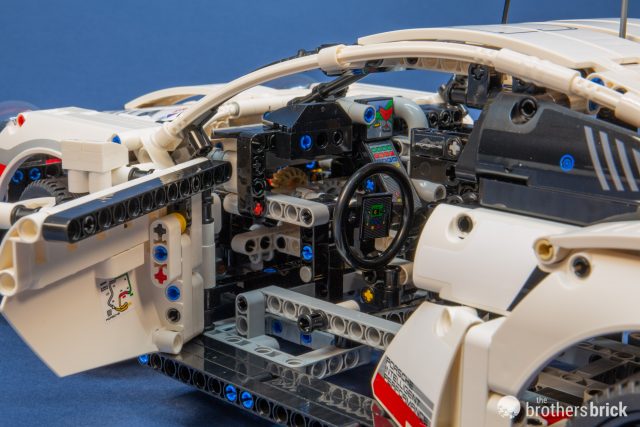 Overall, it’s not a bad facsimile of the real deal, though the steering wheel is in need of a better design in addition to being mounted a bit higher.
Overall, it’s not a bad facsimile of the real deal, though the steering wheel is in need of a better design in addition to being mounted a bit higher.
On the opposite side (we can’t call rightfully call it the passenger side, since there’s only one seat), we can get a good look at the ad-hoc air conditioning vent system that wraps around the center console. The rest of the details are a severe letdown, however. Where the passenger seat would usually be, a variety of wires, fuses, and other gizmos are stickered on haphazardly placed tiles with exposed studs between them, giving it an unfinished look. The long red cylinder is likely meant to be a fire extinguisher, but it bears little resemblance.
The working features on this model are quite limited, boiling down to steering, suspension, moving pistons, and opening engine cover and doors. The front hood does not open. The bar down the center of the windshield is actually the single wiper blade, which rests in the vertical position. Its simple design feels monumentally underwhelming, and it’s hard to tell that’s what it’s meant to be at all.
The engine cover hides the mid-mounted engine with exposed pistons. The rear wheels are geared into the pistons via the differential.
Comparisons to the 911 GT3 RS are inevitable, as my constant references throughout this article have already proven. Let’s take a look at them side by side, then. It’s immediately obvious that the RSR is a smaller scale than the GT3 RS, though both cars are stunning. It’s unfortunate that you won’t be able to display them side by side as equals, since having both the track and race versions of Porsche’s top 911 model would be a great display for any LEGO Porsche enthusiast (which I count myself among, as my long-time username of Porschecm2 evidences).
 Looking at them from above, the distinction is even more clear. However, hefting them the difference is absolutely unmistakable, as the lack of a working gearbox and other internals makes the RSR’s weight more than 45 percent less than that of the GT3 RS (2.9lbs versus 5.3lbs, respectively).
Looking at them from above, the distinction is even more clear. However, hefting them the difference is absolutely unmistakable, as the lack of a working gearbox and other internals makes the RSR’s weight more than 45 percent less than that of the GT3 RS (2.9lbs versus 5.3lbs, respectively).
Together the with the Chiron, they look terrific even with the scales being a bit mixed.
Conclusion & recommendation
The Porsche 911 RSR’s exterior comes close to being on par with the premium Chiron and 911 GT3 RS. The interior is significantly less complex and lacks many of the features of those sets, but it’s also priced to reflect this difference, coming in at half the price of those models. The working features all function well, and while there’s nothing innovative, there’s also little to complain about in these tried-and-true designs aside from a bit of steering slop. Certain parts of the design, however, fall well below expectations, such as the windshield wiper and driver’s compartment. The passenger compartment is frankly hideous and is a distinct black mark on the design. The lack of numbered bags simply isn’t acceptable in a new set of this size in 2018. And while it’s minor, there’s also a mistake in the instructions which adds to the overall rushed feeling of this set (page 174, for those curious).
Nevertheless, despite a few missteps, if you can be content to spread out your LEGO bricks all over the floor or dining room table and devote a good few hours to searching for pieces and building, you’ll be rewarded with a great looking model of one of Porsche’s most groundbreaking racecars.
LEGO Technic 42096 Porsche 911 RSR will be available on January 1 from the LEGO Shop online in North America ($149.99 in the US, $199.99 in Canada) and December 26 in Europe (£139.99 in the UK). It is also available from third-party sellers on eBay and BrickLink.
Also check out the LEGO Porsche 911 RSR ($29.99 in the US) from the Speed Champions theme for a less pricey RSR experience.
The LEGO Group sent The Brothers Brick an early copy of this set for review. Providing TBB with products for review guarantees neither coverage nor positive reviews.










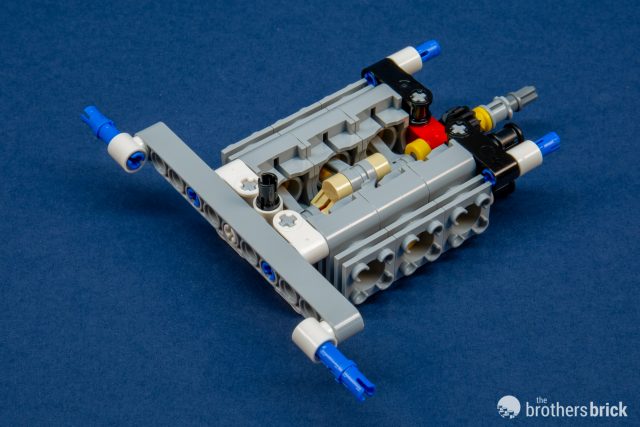


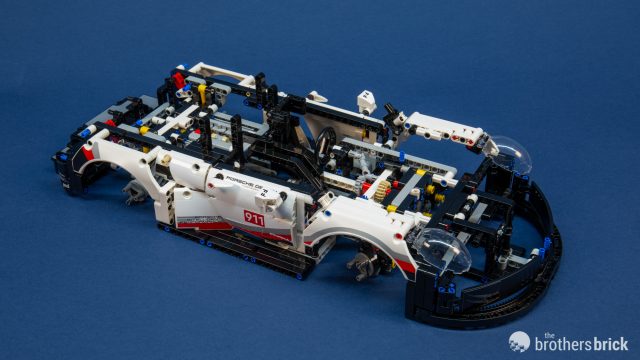


















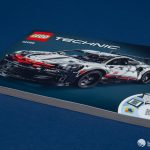




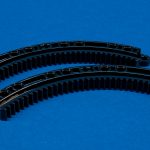
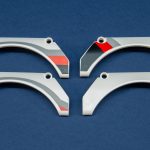
























It could be the angle of the pictures, but that front diffuser looks too tall to me, making the shape of the nose just…. wrong.
For the towball pins, you could be right about them being produced in that colour for another set but I fear it’s yet another step in the Technic Colour Barf project.
I recognise the Ikea sorting trays – we have a few ourselves. We have moved on to the Kuggis tray though; more pockets and made from a different plastic making it more rigid.
I’m glad that the bags aren’t numbered, it felt way to guided and aimed at children from 9 abd below…
The wheel arches are different than the one from orange Porsche 911 GT3 RS, they are smaller in lenght, but same dimension in height and thickness. Thanks for the very good review!
Great detailed review! Regarding the unnumbered bags, 42069 had them as well with 2382 pieces :)
i’m wondering if those printed wheel arches will force me to apply all the stickers. i’ve yet to use any stickers on the large technic sets i’ve purchased. i suppose it doesn’t matter so much since i would take this apart once i’ve put it together anyway.
A very thorough review! Please note that the models you listed for comparison as “standard Technic sets” (8145 Ferrari GTB, 8461 Williams F1, 8653 Enzo, 8674 Ferrari F1) are not Technic sets. Those are all in the “Racers” line. This new Porsche therefore has more in common with Racers than many of the previous Technic supercars.
There’s a printing error on page 154 as well :/ . It definitely gives the feeling of being rushed
Great review. I’m a bit of a pedant when it comes to Porsche though so feel the need to point out:
The model depicted in 42096 is the 2018 model of the 911 RSR, not the 2017 model. A minor difference but actually one that affects the look of the car quite a lot – a different aero package, exhaust routing and headlamp lens colour being the biggest differences.
Additionally, all the 991 model RSRs have been based on the wide body Carrera S, not the GT3 RS (as with the 996, 997 model RSRs). As the 991 GT3 RS didn’t exist when the RSR was originally homologated. RSRs based on GT3s, are designated as GT3 RSRs by way of differentiation.
Also, the rear view camera screen is not as fanciful as it may seem, actual footage can be seen here: https://www.youtube.com/watch?v=96vL7HMrExc (Corvette were first to adopt the system but the other manufacturers have since followed suit).
There is other mistake at page 201 the headlights go down for some reason :/